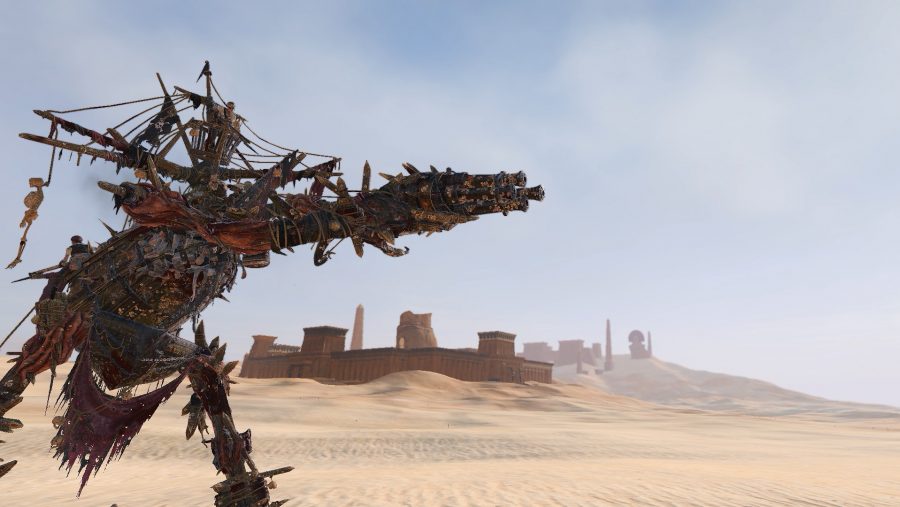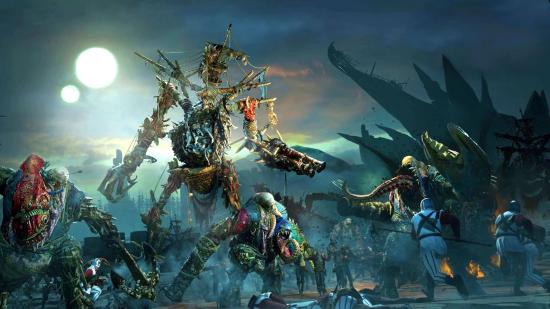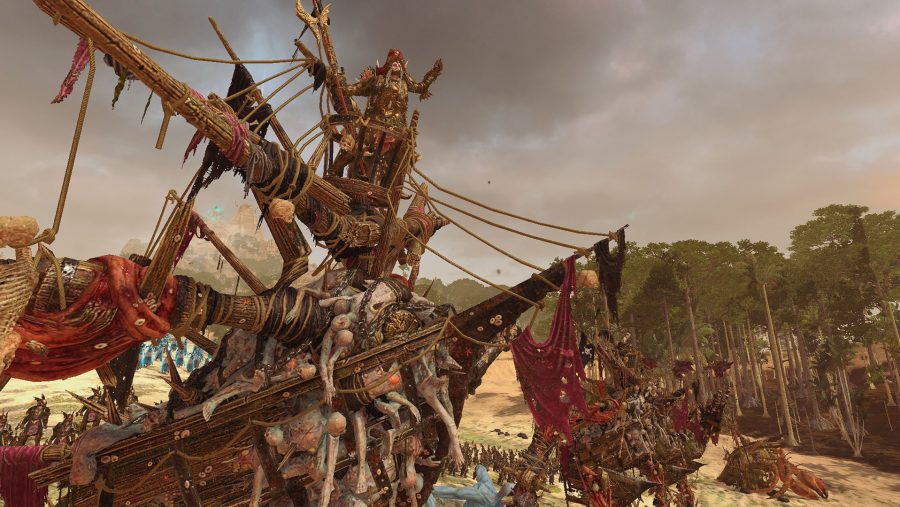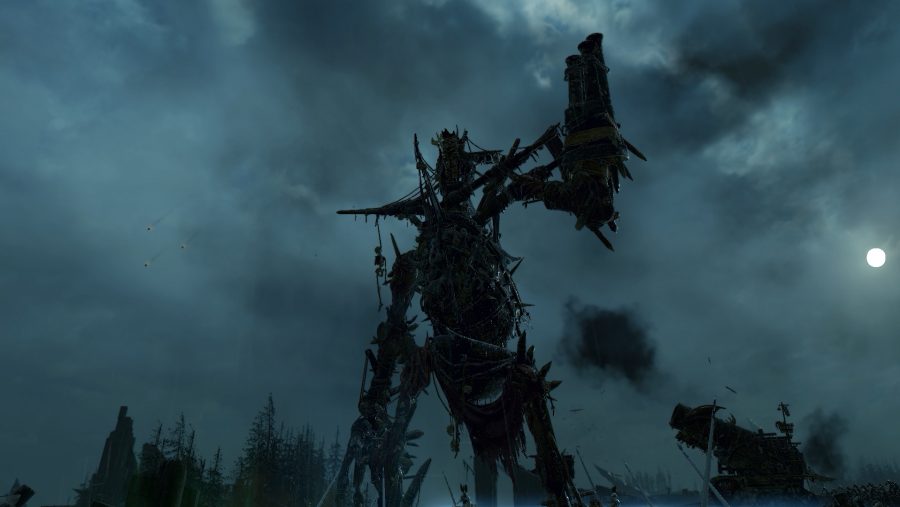Perhaps it’s the slime glinting off its hull in the sunlight, but one star shines particularly brightly in Total War: Warhammer 2’s brilliant Curse of the Vampire Coast DLC – the Necrofex Colossus. A towering construct built from pirate shipwrecks and corpses, it may be made of wood, but it’s the most metal unit in the game so far. That’s why, when we got the chance to discuss the Vampire Coast with Total War developer Creative Assembly, the origins of the Necrofex Colossus were upmost in our minds.
“We always go really deep into the lore, and we always know that we want to get big units that are crazy to look at,” explains designer Mitch Heastie. The Necrofex Colossus is mentioned in old White Dwarf magazines and army books, if you dig back far enough. The primary source, though, was Monstrous Arcanum – a compendium of rules for the outsized models that represent Warhammer’s more obscure monsters.
“There’s lots of little tidbits here and there that we kind of all pulled together just to create one kind of overall vision,” Heastie says. Fitting for a monster cobbled together from driftwood and drowned sailors.
With the Vampire Coast being such an artillery-led faction, a cannon – absent in all of the lore mentions we’ve been able to find so far – became a part of that vision.
But this in turn raised the problem of “trying to find a role for [the Necrofex] in a roster that is so heavily gun-orientated,” Heastie says. “It was difficult to find a role for it that was different to something like the carronade, the mortar, or the other large monsters like the Leviathan. You really need to find a niche for him. But I do think we did that.”

cannons versus rocks
We’ve seen shooting monsters before, like the Beastmen’s Cygor. But the Necrofex differs in one crucial respect – it can fire while moving.
“We found a lot of frustration with the Cygor and the gameplay it promotes,” designer Gary Deans says. “Something will be running away, and the Cygor will pursue, then he’ll try and throw a rock, but then the enemy is out of range. Having [the Necrofex] just move and fire felt more seamless, and more smooth. It does increase its power, though, as it means its threat range is a lot greater than things like a Cygor.”
I often saw Necrofex Colossi rack up over 200 kills per battle, and having stumbled once at the final battle of the campaign, brought six along with me when tailoring my army for a second attempt. After that I won handily. But both Deans and Heastie say it’s not overpowered, and has its weaknesses.
Torn? Look over our list of the best Total War games
“It’s got decent health, but its armour is pretty poor. You can burn them down quite quickly if you can catch them”, though we wouldn’t advise pursuing with anything that doesn’t have the ‘anti-large’ specialism. The Vampire Coast also have plenty of options to slow you down, and you’ll be weathering cannon fire all the while.
This need to shield the Necrofex from unwise fights in melee gives undead generals (or admirals, in this case) a neat incentive to master the classic undead tactic of ‘tarpitting’ – tying the enemy up in combat with masses of expendable troops while positioning heavy hitters for a knockout blow. “There’s also the ‘Abandon Ship’ ability,” Deans says, “which we’ve added for this unit, whereby when it drops below a certain threshold of health, it’ll expel zombies from its hull as a defensive mechanism. This allows you to literally put a wall of zombies between you and your enemy, keep [the Necrofex] alive, and escape from that situation.”
how to take a walking ship seriously
If these mechanical conversations are half of the concepting process, the other half concerns personality – giving the unit its soul, if you will (a thing that the Necrofex lacks in at least one other sense). The key word Creative Assembly wanted to convey with the Necrofex Colossus was “intimidating”.
“We wanted this thing to do something that other units haven’t done before.” Heastie says. “It’s an artillery piece, but you can have it on your frontline – you’ll start firing with its cannon, and not only that, but you can walk it up and keep firing. Then when it gets into melee it can do crazy damage there, as well. It can do a bit of everything.”
Related: Total War has given us some of the best strategy games
‘Intimidating’, though, is an odd word to describe something so memeable and, in a certain light at least, comic. This is, after all, a rickety walking ship with a rotating cannon on its arm. It’s bizarre and absurd, like a 17th century Transformer, and while I’ve never pretended to understand what Michael Bay was attempting with those movies, if it was to make Transformers scary, he failed.
And yet, in the lore, the Necrofex Colossus is terrifying. Its wood is fused with corpses which are then reanimated through magic and living sacrifices to give it impetus. You can see them in the game, reaching out of the Colossus’s chest piece – which, again, is the hull of a ship, and brings us back to that absurdity. Is it me, or is there a bit of a tonal disconnect there?
Into towering structures? Tuck into the best PCGamesN long reads
“I think with Warhammer you can get away with some tongue-in-cheek depictions of a lot of the monsters,” Heastie says. “But no, this thing… not only if you zoom in does it look grotesque and a bit intimidating, but it also backs that up in battle. Whether you’re playing against him or playing with him, you always get that sense of raw power. I don’t think people will take him lightly.”
Monstrous arcana
But there’s another problem Creative Assembly had to solve. The Monstrous Arcanum sketch is evocative, but it’s a long way short of a technical blueprint. How does an artist go about making a fully poseable rig from something so messy? And having done so, how should it move?
“It was complicated,” admits animator Eva Seyeux. “And it has a peg leg, so we had to find references for things that would walk in a broken way.”
As we learned when discussing the Hell Pit Abomination, a rig that looks sensible when static can take a turn for the silly when set into motion. The Necrofex, with all its spiky pieces of wood jutting out at odd angles, looks especially prone to clipping bits of itself into other bits of itself. As it turned out, adding a gun – which you’ll notice the original Monstrous Arcanum sketch does not have – exacerbated these problems.

“The arms were the most problematic,” Seyeux says. “Because they have bits of wood sticking out, and when its arm would rotate to reload the gun, it was going through itself all the time. We had to work a lot with the character artists so they would fix it while we were animating.”
We’ve seen undead constructs before, in the Tomb Kings. But the Necrofex Colossus is different in so many ways – construction material, craftsmanship, armament, personality. Where your Necrosphinxes and Hierotitans are all efficient, animal power in their attack animations and barely move when idle, the Necrofex is rather less… stony.
“With the Tomb King [constructs], when we started we were like, ‘they all have to be statues’. We wanted some drama with [the Necrofex],” Seyeux says. “So it has a big reloading animation, and it has some recoil when shooting. When it’s moving or shooting, everybody on the battlefield has to know about it.”
Thanks to its versatility, the Necrofex is as deadly as its theatricality suggests. In fact, Heastie says “its raw damage output is probably greater” than any other monster in the game. “There’s no situation where it can’t contribute,” he says. “Though it does have counters, it’s one of the most viable monsters I think we’ve done so far.”


